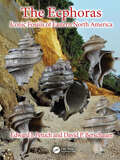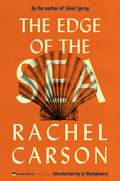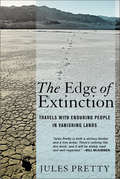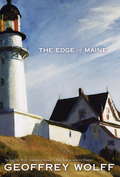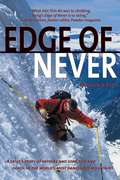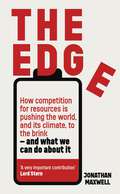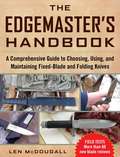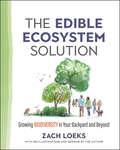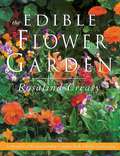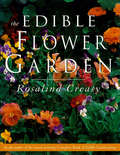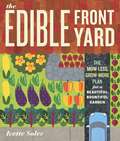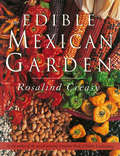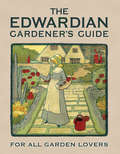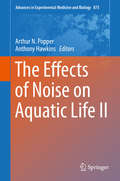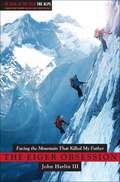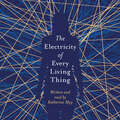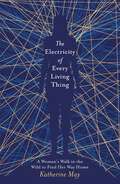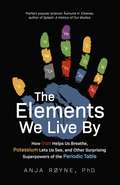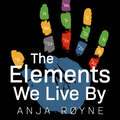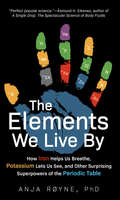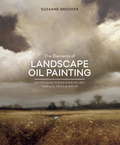- Table View
- List View
The Ecphoras: Iconic Fossils of Eastern North America
by Edward J. Petuch David P. BerschauerIn the Miocene and Pliocene fossil shell beds of the eastern United States, the single most spectacular molluscan species radiation is seen in the ecphora shells (the Tribe Ecphorini). These bizarrely shaped gastropods, with their distinctive ribbed shell sculpture, represent a separate branch of the Subfamily Ocenebridae, Family Muricidae. Characteristically, these muricid gastropods are heavily ornamented with spiral ribs and cords and are considered some of the most beautiful and interesting groups of fossil mollusks found along the Atlantic Coastal Plain and Floridian Peninsula. The ecphoras are greatly sought after by fossil collectors. The ecphora faunas, and their individual species and subspecies, are illustrated and described in detail, along with photographs of ecphora-bearing geological units and in-situ specimens. The authors list the 67 known species and subspecies that are recognized as valid, arranged by the eight genera and five subgenera that encompass these taxa.
The Edge Of The Sea: Under The Sea-wind / The Sea Around Us / The Edge Of The Sea
by Rachel CarsonWith all the hallmarks of Rachel Carson's luminous prose combined with a scientifically accurate exploration of the Atlantic seashore comes a hauntingly beautiful account of what one can find at the edge of the sea. "The edge of the sea is a strange and beautiful place." Focusing on the plants and invertebrates surviving in the Atlantic zones between the lowest and the highest tides, between Newfoundland and the Florida Keys, The Edge of the Sea is a book to be read for pleasure as well as a practical identification guide. Its appendix and index make it a great reference tool for those interested in plant and animal life around tidepools. A new generation of readers is already discovering why Rachel Carson's books have become cornerstones of the environmental and conservation movements. With an Introduction by Sue Hubbell.
The Edge of Extinction: Travels with Enduring People in Vanishing Lands
by Jules PrettyIn The Edge of Extinction, Jules Pretty explores life and change in a dozen environments and cultures across the world, taking us on a series of remarkable journeys through deserts, coasts, mountains, steppes, snowscapes, marshes, and farms to show that there are many different ways to live in cooperation with nature. From these accounts of people living close to the land and close to the edge emerge a larger story about sustainability and the future of the planet. Pretty addresses not only current threats to natural and cultural diversity but also the unsustainability of modern lifestyles typical of industrialized countries. In a very real sense, Pretty discovers, what we manage to preserve now may well save us later. Jules Pretty's travels take him among the Maori people along the coasts of the Pacific, into the mountains of China, and across petroglyph-rich deserts of Australia. He treks with nomads over the continent-wide steppes of Tuva in southern Siberia, walks and boats in the wildlife-rich inland swamps of southern Africa, and experiences the Arctic with ice fishermen in Finland. He explores the coasts and inland marshes of eastern England and Northern Ireland and accompanies Innu people across the taiga’s snowy forests and the lakes of the Labrador interior. Pretty concludes his global journey immersed in the discrete cultures and landscapes embedded within the American landscape: the small farms of the Amish, the swamps of the Cajuns in the deep South, and the deserts of California. The diverse people Pretty meets in The Edge of Extinction display deep pride in their relationships with the land and are only willing to join with the modern world on their own terms. By the examples they set, they offer valuable lessons for anyone seeking to find harmony in a world cracking under the pressures of apparently insatiable consumption patterns of the affluent.
The Edge of Maine
by Geoffrey WolffNow, with the voice of a passionate insider, he brings readers into the heart of this striking region and explains what makes it unique. Starting with a gripping tale about being lost offshore in the fog with inadequate navigational aids, Wolff goes on to describe the coast's geological history and discovery by Europeans. He then turns a keen eye towards Mainers, their mores and peculiarities, and to the summer rusticators who for generations have invaded the stunning waterfronts. A section on boat building celebrates the extraordinary rescue of Maine's foremost craft; another on lobsters tells the rich story of the custom, taste, commerce, environmental conflict, and scientific mystery surrounding these critical crustaceans. Here is a true feast--travel literature at its best.
The Edge of Never: A Skier's Story of Life, Death, and Dreams in the World's Most Dangerous Mountains
by William A. KerigIn the world of big-mountain skiing, Trevor Petersen was a legend. Appearing in countless films, magazines and photo shoots, his ponytail flying behind him, he was the very embodiment of the freewheeling spirit of extreme skiing in the 1980s and early '90s. Then it all came to an end. On February 26, 1996, while skiing in Chamonix, France - the so-called Death Sport Capital of the World - an avalanche swept Trevor away. His body was found sitting up in the snow as if gazing at the mountains he loved. Nearly a decade later, Trevor's fifteen-year-old son, Kye Petersen, a rising star in his own right, traveled to Chamonix to ski the run that took his father's life and, with the aid of some of the world's greatest ski mountaineers, to become a member of skiing's big-mountain tribe. There to chronicle Kye's story was William A. Kerig, a filmmaker with a dream of his own - to create a film about the soul of big-mountain skiing and the band of mountaineers who ski the steepest, wildest, most dangerous terrain in the world. In The Edge of Never, Kerig gives us not only a ripping adventure tale about a young man coming of age but a frank and subtle portrait of the extreme skiers who "live big" in the face of death and risk everything to experience the fullness of life in the mountains.
The Edge: How competition for resources is pushing the world, and its climate, to the brink – and what we can do about it.
by Jonathan MaxwellWe live in a World which, though the origins are long, seems suddenly transformed by economic events way out of our control. In seeking stability, we must acknowledge the seismic scale of the challenge, and understand the devastating impact of global energy inefficiency. Every society, organisation, business, household and individual must put efficiency first - not just to save money and carbon and improve resilience, but to reduce the risk, or effect, of conflict.THE EDGE is a very contemporary look at how the world has been transformed by recent economic events, focusing on climate change, the war in Ukraine, the Chinese economy and the challenges the world faces around inflation, energy, transport, fuel, imports etc. Written from an economist/investor's perspective, with lessons for pretty much every institution challenged by these developments, it is a timely and essential resource authored by a global expert with peerless connections, from major organisations to government insiders, from investors to energy corporations. It will help businesses and economies currently at the mercy of the markets to transition towards sustainability, productivity and prosperity, and help everyone understand the world in 2023.
The Edgemaster's Handbook: A Comprehensive Guide to Choosing, Using, and Maintaining Fixed-Blade and Folding Knives
by Len McDougallDo you feel a soul-deep connection with knives and tools that are engineered to cut through other materials? Does having a sturdy knife on your person imbue you with a profound, but somehow unidentifiable, sense of security? The Edgemaster’s Handbook is just that: a book completely dedicated to the care and usage of knives. Whether handling a dagger, stiletto, or bolo, you’ll learn the knife’s purpose and how to use is properly while keeping the blade clean and yourself safe. Len McDougall has spent his entire life—almost sixty years—learning the nuts and bolts of staying alive under adverse conditions and the mastery of weapons. And now more than ever we will need to take his lessons seriously, as understanding what to expect and how to adapt will increase the odds for survival. Featuring methods that have been personally tested through hard, field-proven experiences, you will learn everything needed to use knives for both outdoor living and protection. Included in this book are many lessons on knives, including: Sharpening a blade How to properly identify different types Collecting Using for survival and self-defense And so much more Whether for the collector or the outdoorsman, McDougall shares all his knowledge and understanding of this tool for you to understand and better appreciate. The Edgemaster’s Handbook is just that; a collection of tips, tricks, lessons, and knowledge from a professional that will make sure you master the usage of knives in your daily life.
The Edible Ecosystem Solution: Growing Biodiversity in Your Backyard and Beyond
by Zach LoeksStart a peaceful revolution by planting an edible ecosystem and sharing the experience with your neighborsHumans have always thrived in rich, diverse, edible ecosystems. Yet most cities and suburbs are blanketed by lawns, ornamentals, and a lack of biodiversity, let alone anything edible. It is within these sterile landscapes that seeds of an edible ecosystem lie.The Edible Ecosystem Solution is a comprehensive, practical guidebook that looks at underutilized spaces to reveal the many opportunities for landscape transformation that are both far-reaching and immediately beneficial and enjoyable. Contents include:Hundreds of full-color infographics, illustrations, and photographs that clearly outline the principles and concepts of edible landscape design and benefitsHow to get started with as little as 25 square feet of landHow to transition a garden plot into a place of edible abundance and an edible biodiversity hot spot, living laboratory, and a source point for transitioning and transforming community and cultureChoosing appropriate plants for insects, wildlife, and food productionScaling up and networking backyard edible ecosystems at the neighborhood level and beyond to build community food security and resilience.The Edible Ecosystem Solution is for everyone with access to a bit of yard, a desire for food security, biodiversity, and a beautiful and resilient community, and for anyone who wants to reclaim humanity's place in a rich, abundant, edible ecosystem.
The Edible Flower Garden
by Rosalind CreasyA comprehensive guide to selecting and growing flowers that can be used for cookery, both as garnishes and as ingredients.
The Edible Flower Garden
by Rosalind CreasyThe Edible Flower Garden is a beautiful collection of flowers that can be used for cookery: from candied violets and roses to decorate appetizers and cakes, to nasturtiums for a colorful shrimp salad, to day lily buds, pink clover, and wild mustard flowers that are tossed together in a spectacular stir-fry.
The Edible Front Yard: The Mow-Less, Grow-More Plan for a Beautiful, Bountiful Garden
by Ivette Soler“Front lawns, beware: The Germinatrix has you in her crosshairs! Ivette Soler is a welcome voice urging us to mow less and grow some food—in her uniquely fun, infectious yet informative way.” —Garden RantPeople everywhere are turning patches of soil into bountiful vegetable gardens, and each spring a new crop of beginners pick up trowels and plant seeds for the first time. They're planting tomatoes in raised beds, runner beans in small plots, and strawberries in containers. But there is one place that has, until now, been woefully neglected—the front yard. And there's good reason. The typical veggie garden, with its raised beds and plots, is not the most attractive type of garden, and favorite edible plants like tomatoes and cucumbers have a tendency to look a scraggily, even in their prime. But The Edible Front Yard isn't about the typical veggie garden, and author Ivette Soler is passionate about putting edibles up front and creating edible gardens with curb appeal. Soler offers step-by-step instructions for converting all or part of a lawn into an edible paradise; specific guidelines for selecting and planting the most attractive edible plants; and design advice and plans for the best placement and for combining edibles with ornamentals in pleasing ways. Inspiring and accessible, The Edible Front Yard is a one-stop resource for a front-and-center edible garden that is both beautiful and bountiful year-round.
The Edible Mexican Garden
by Rosalind CreasyWith gorgeous, four-color photographs, and simple yet authoritative text, award-winning author Rosalind Creasy offers four new volumes in her popular Edible Garden series, each featuring helpful hints, expert gardening techniques, delicious recipes, and interviews with master gardeners and renowned chefs. The most unassuming of garden vegetables from your garden- corn, beans, peppers, greens, and onions- are transformed into traditional and contemporary Mexican dishes and delicacies to awaken the palate and entice the eye.
The Edwardian Gardener's Guide
by Twigs WayIt is Edwardian England, and a delightful flower garden and fruitful allotment are matters of personal pride, boons for the dinner table, and even 'important acts of local patriotism'. The Edwardian Gardener's Guide selects nuggets of wisdom from the best-selling One & All garden books, originally published in 1913. In these short booklets, the foremost agricultural and horticultural writers of the period revealed fashions in gardening styles, the best seasonal plants, how to enhance food production and now best to lay out adventurous rockeries, ferneries and grottoes. Packed with charming contemporary advertisements and color illustrations, this handbook gives a glimpse of the pre-First World War 'golden era' of British gardening. With an introduction by garden historian, Twigs Way.
The Effects of Noise on Aquatic Life II
by Arthur N. Popper Anthony HawkinsThe meeting of Aquatic Noise 2013 will introduce participants to the most recent research data, regulatory issues and thinking about effects of man-made noise and will foster critical cross-disciplinary discussion between the participants. Emphasis will be on the cross-fertilization of ideas and findings across species and noise sources. As with its predecessor, The Effects of Noise on Aquatic Life: 3rd International Conference will encourage discussion of the impact of underwater sound, its regulation and mitigation of its effects. With over 100 contributions from leading researchers, a wide range of sources of underwater sound will be considered.
The Eiger Obsession: Facing the Mountain That Killed My Father
by John Harlin IIIIn the 1960s an American named John Harlin II changed the face of Alpine climbing. Gutsy and gorgeous - he was known as 'the blond god' - Harlin successfully summitted some of the most treacherous mountains in Europe. But it was the North Face of the Eiger that became Harlin's obsession. Living with his wife and two children in Leysin, Switzerland, he spent countless hours planning to climb, waiting to climb, and attempting to climb the massive vertical face. It was the Eiger direct - the direttissima - with which John Harlin was particularly obsessed. He wanted to be the first to complete it, and everyone in the Alpine world knew it. John Harlin III was nine years old when his father made another attempt on a direct ascent of the notorious Eiger. Harlin had put together a terrific team and, despite unending storms, he was poised for the summit dash. It was the moment he had long waited for. When Harlin's rope broke, 2,000 feet from the summit, he plummeted 4,000 feet to his death. In the shadow of tragedy, young John Harlin III came of age possessed with the very same passion for risk that drove his father. But he had also promised his mother, a beautiful and brilliant young widow, that he would not be an Alpine climber. Harlin moved from Europe to America, and, with an insatiable sense of wanderlust, he revelled in downhill skiing and rock-climbing. For years he successfully denied the siren call of the mountain that killed his father. But in 2005, John Harlin could resist no longer. With his nine-year-old daughter, Siena - his very age at the time of his father's death - and with an IMAX Theatre filmmaking crew watching, Harlin set off towards the Eiger.
The Eight Master Lessons of Nature: What Nature Teaches Us About Living Well in the World
by Gary FergusonA riveting manifesto for the millions of people who long to forge a more vital, meaningful connection to the natural world to live a better, more fulfilling life Looking around at the world today—a world of skyscrapers, super highways, melting ice caps, and rampant deforestation—it is easy to feel that humanity has actively severed its ties with nature. It’s no wonder that we are starving to rediscover a connection with the natural world. With new insights into the inner workings of nature's wonders, Gary Ferguson presents a fascinating exploration into how many of the most remarkable aspects of nature are hardwired into our very DNA. What emerges is a dazzling web of connections that holds powerful clues about how to better navigate our daily lives. Through cutting-edge data and research, drawing on science, psychology, history, and philosophy, The Eight Master Lessons of Nature will leave readers with a feeling of hope, excitement, and joy. It is a dazzling statement about the powers of physical, mental, and spiritual wellness that come from reclaiming our relationship with Mother Nature. Lessons about mystery, loss, the fine art of rising again, how animals make us smarter, and how the planet’s elders make us better at life are unforgettable and transformative.
The El Niño-Southern Oscillation Phenomenon
by Edward S. Sarachik Mark A. CaneMany climatic extremes around the globe, such as severe droughts and floods, can be attributed to the periodic warming of the equatorial Pacific sea surface, termed the El Ni#xF1;o or Southern Oscillation (ENSO). Advances in our understanding of ENSO, in which Edward Sarachik and Mark Cane have been key participants, have led to marked improvements in our ability to predict its development months or seasons, allowing adaptation to global impacts. The book introduces basic concepts and builds to more detailed theoretical treatments. Chapters on the structure and dynamics of the tropical ocean and atmosphere place ENSO in a broader observational and theoretical context. Chapters on ENSO prediction, past and future, and impacts introduce broader implications of the phenomenon. This book provides an introduction to all aspects of this most important mode of global climate variability, for research workers and students of all levels in climate science, oceanography and related fields.
The Electric Eel
by Christopher W. CoatesDid you know that the adult eel is blind? That baby eels have bright blue eyes? That a whopping four-fifths of the eel's body is tail? There are lots more interesting things to know about eels, and you can read about them in this delightful book.
The Electricity of Every Living Thing: A Woman's Walk in the Wild to Find Her Way Home
by Katherine MayLast summer, Katherine May was approaching 40, feeling overwhelmed by motherhood and lacking connection with others, lost in a world of inundation and expectation. She had always felt different but this feeling was new. She wanted to get out, get free and find herself again - and so set about walking the rugged 450 mile South West Coast Path. However, this journey uncovers more than she ever imagined. By chance, en route to the walk, Katherine hears a radio show and the guests are speaking about Asperger's Syndrome. Things begin to fall into place - could this explain the white-outs, the excruciating confusion around social contact, the electric feeling of every living thing?After a formal diagnosis, Katherine begins to unravel this new perspective of her life. Through her physical journey comes an emotional one - of accepting who she is and moving forward. It's not just about walking or Asperger's; this is one woman's journey to feel free within herself, something that everyone can relate to.Read by Nathalie Buscombe(p) Orion Publishing Group 2018
The Electricity of Every Living Thing: From the bestselling author of Wintering
by Katherine MayFrom the bestselling author of Wintering, Katherine May, The Electricity of Every Living Thing is a life-affirming and poignant exploration of nature, and how reconnecting to wild landscapes can create peace in our unquiet minds.'A windswept tale, beautifully told' Raynor Winn, author of The Salt Path 'A manifesto for the value of difficult people. I loved it' Amy Liptrot, author of The OutrunIn August 2015, Katherine May set out to walk the 630-mile South West Coast Path. She wanted to understand why she had stopped coping with everyday life; why motherhood had been so overwhelming and isolating, and why the world felt full of inundation and expectations she can't meet. Setting her feet down on the rugged and difficult path by the sea, the answer begins to unfold.The Electricity of Every Living Thing tells the story of the year in which Katherine comes to terms with a diagnosis which shakes her to her core. It leads to a re-evaluation of her life so far - a kinder one, which finally allows her to be different rather than simply awkward, arrogant or unfeeling. The physical and psychological journeys become inextricably entwined, and as Katherine finds her way across the untameable coast, she also finds the way to herself.What readers are saying about The Electricity of Every Living Thing:'Honest and sensitive' 'The astonishing sensitivity and awareness in her writing, both about the beautiful landscapes and nature around on her walks, and in relation to her family, friends and self put paid to many outdated myths about what it is like to be autistic''Compelling and transformative. I could not put this book down so I stayed in bed and read it in one go.''Katherine has a fantastic way with words, I could read her books for hours on end, they are calming and relatable.''Read it - you won't regret it.'
The Elements We Live By: How Iron Helps Us Breathe, Potassium Lets Us See, and Other Surprising Superpowers of the Periodic Table
by Anja RøyneWINNER OF THE 2018 BRAGE PRIZE'[T]his lovely book. An enjoyable sweep through topics ranging from respiration to space exploration -solid science presented in an engagingly human way' Andrew Crumey, author of The Great Chain of Unbeing'Perfect popular science . . . not just a well-written story about the elements, but a book about being human in the world today'Åsmund H. Eikenes, author of Splash: A History of Our BodiesWe all know that we depend on elements for survival - from oxygen in the air we breathe to carbon in the molecular structures of all living things. But we seldom appreciate how, say, phosphorus holds our DNA together or how potassium powers our optic nerves enabling us to see.Physicist and award-winning author Anja Røyne takes us on an astonishing journey through chemistry and physics, introducing the building blocks from which we humans - and everything else in the world - are made. Not only does Røyne explain why our bodies need iron, phosphorus, silicon, potassium and many more elements in just the right amounts in order to function, she also shows us where in the world these precious elements are found (some of them in limited and quickly depleting quantities).Røyne helps us understand how precariously balanced our lives - and ways of living - really are, and to appreciate little known and generally unsung heroes of the periodic table in an entirely new light.
The Elements We Live By: How Iron Helps Us Breathe, Potassium Lets Us See, and Other Surprising Superpowers of the Periodic Table
by Anja RøyneWINNER OF THE 2018 BRAGE PRIZE'[T]his lovely book. An enjoyable sweep through topics ranging from respiration to space exploration -solid science presented in an engagingly human way' Andrew Crumey, author of The Great Chain of Unbeing'Perfect popular science . . . not just a well-written story about the elements, but a book about being human in the world today'Åsmund H. Eikenes, author of Splash: A History of Our BodiesWe all know that we depend on elements for survival - from oxygen in the air we breathe to carbon in the molecular structures of all living things. But we seldom appreciate how, say, phosphorus holds our DNA together or how potassium powers our optic nerves enabling us to see.Physicist and award-winning author Anja Røyne takes us on an astonishing journey through chemistry and physics, introducing the building blocks from which we humans - and everything else in the world - are made. Not only does Røyne explain why our bodies need iron, phosphorus, silicon, potassium and many more elements in just the right amounts in order to function, she also shows us where in the world these precious elements are found (some of them in limited and quickly depleting quantities).Røyne helps us understand how precariously balanced our lives - and ways of living - really are, and to appreciate little known and generally unsung heroes of the periodic table in an entirely new light.
The Elements We Live By: How Iron Helps Us Breathe, Potassium Lets Us See, and Other Surprising Superpowers of the Periodic Table
by Anja RøyneThis “excellent” popular science book explores just what we—and the things around us—are made of (Aftenposten, Norway).Some elements get all the attention: glittering gold, radioactive uranium—materials we call “precious” because they are so rare. But what could be more precious than the building blocks of life—from the oxygen in our air to the carbon in all living things?In The Elements We Live By, physicist and award-winning author Anja Røyne reminds us that we’d be lost without the quiet heroes of the periodic table. Our bodies need phosphorous to hold our DNA together, potassium to power our optic nerves, and many more elements—in just the right amounts—to function. Other fundamental elements keep our technology (and society) running: Our phones contain arsenic, boron, and gallium to control signals and store information; indium and tin for the touch screen; and lithium for the battery.Everything is made of elements—every galaxy, star, and planet—from the iron in Earth’s core to the silicon in its sand. But that doesn’t mean the elements we rely on will never run out; for example, about half the lithium we need is extracted from rocks in Australia, and the other half is from saltwater in Argentina and Chile. As Røyne travels the world to find where these elements exist (some in ever-shrinking amounts), she shows how vitally urgent it is for us to protect them—the elements of our very existence.“Not just a discussion of basic chemistry, this is a volume that looks at the human impact on the planet and what we can learn from nature…Useful for science or sociology courses that address the various impacts of natural resource development or for popular science readers.” —School Library Journal
The Elements of Landscape Oil Painting
by Suzanne BrookerA landscape painting guide for oil painters that breaks landscapes down into component elements from nature, and showcases tools and techniques used by classic and modern oil painters for bringing these scenes to life. Landscape painting is one of the most popular subjects for painters working in the medium of oils--from classic masters to contemporary artists. In The Elements of Landscape Oil Painting, established Watson-Guptill author and noted instructor/painter Suzanne Brooker presents the fundamentals necessary for mastering landscape oil painting, breaking landscapes down into component parts: sky, terrain, trees, and water. Each featured element builds off the previous, with additional lessons on the latest brushes, paints, and other tools used by artists. Key methods like observation, rendering, and color mixing are supported by demonstration paintings and samples from a variety of the best landscape oil painters of all time. With The Elements of Landscape Oil Painting, oil painters looking to break into landscape painting or enhance their work will find all the necessary ingredients for success.
